Compression socks have become a go-to solution for many people looking to improve circulation, reduce swelling, and recover faster. Whether for athletes, travelers, or those with medical conditions, these socks are praised for their ability to promote healthy blood flow. In fact, the global compression stockings market is expected to reach USD 1,222.9 million by 2031, growing at a CAGR of 4.2% between 2024 and 2031.

But as their popularity grows, so do the questions about how to use them properly. One key concern is whether wearing compression socks at night is safe. While they offer several benefits during the day, experts warn about potential risks when worn while sleeping. So, should your customers wear them overnight, or is it better to save them for daytime use?
In this article, we’ll explore the truth behind wearing compression socks at night, helping you provide the right advice to your customers and ensure their safety and comfort.
Quick Answer
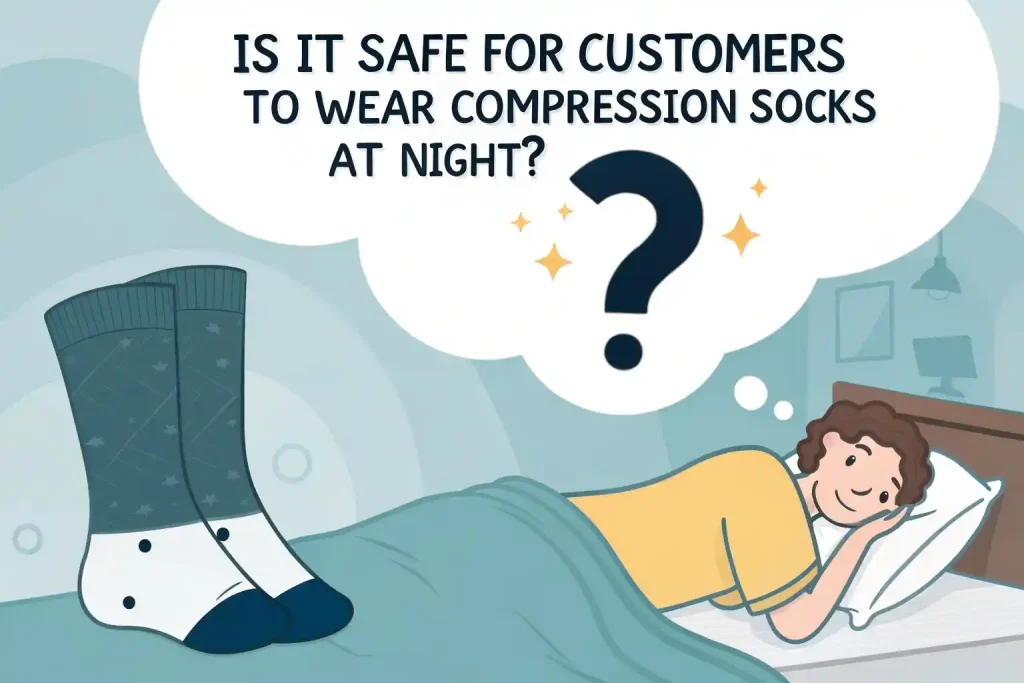
For most healthy individuals, wearing compression socks overnight is not recommended.
While they support circulation during the day, nighttime use can cause skin irritation, discomfort, and in some cases, restrict blood flow.
Exceptions exist for certain medical situations — but only under doctors’ supervision.
How Compression Socks Work
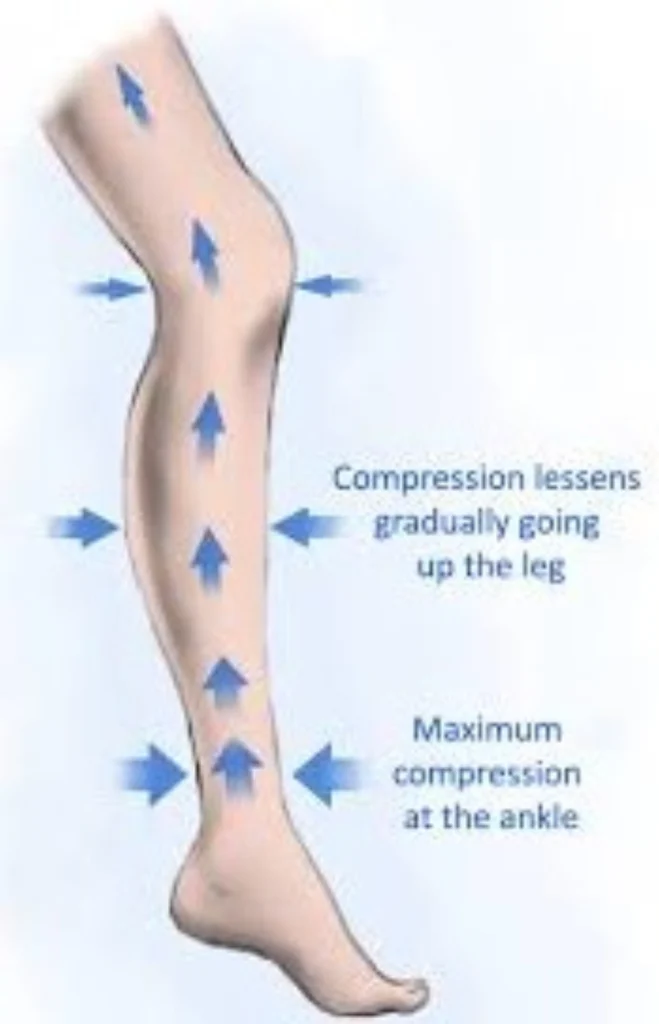
Compression socks work by applying graduated pressure to the legs. This pressure is:
- Firmest at the ankle, helping push blood upward;
- Gradually lighter toward the calf, facilitating natural blood return to the heart.
This design improves circulation, reduces swelling, and supports vein health. Typical daytime benefits include:
- Decreased leg fatigue after prolonged standing or sitting;
- Reduced swelling for travelers, pregnant women, and those with venous disorders;
- Faster muscle recovery for athletes after exercise.
Day vs. Night Circulation
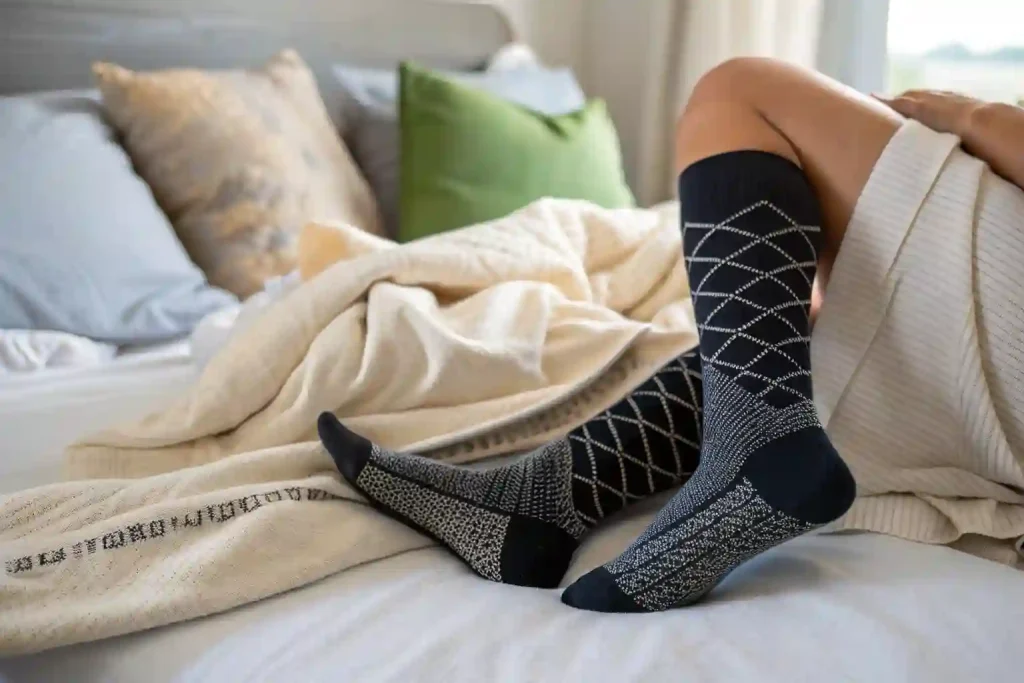
When you are standing or sitting, gravity pulls blood downward, making it harder for your veins to return blood to the heart. Compression socks provide crucial support during these times by applying pressure that helps counteract gravity’s effects.
However, the situation changes at night. While lying down, the body is in a horizontal position, which naturally facilitates blood flow without the need for extra compression. In this resting state, the veins don’t have to work against gravity, and circulation improves on its own. Therefore, wearing compression socks during sleep often offers little additional benefit and could even interfere with the body’s natural healing processes.
Understanding this difference is key to advising customers on when compression socks are most effective and safe to use.
Common Myths About Nighttime Use of Compression Stockings
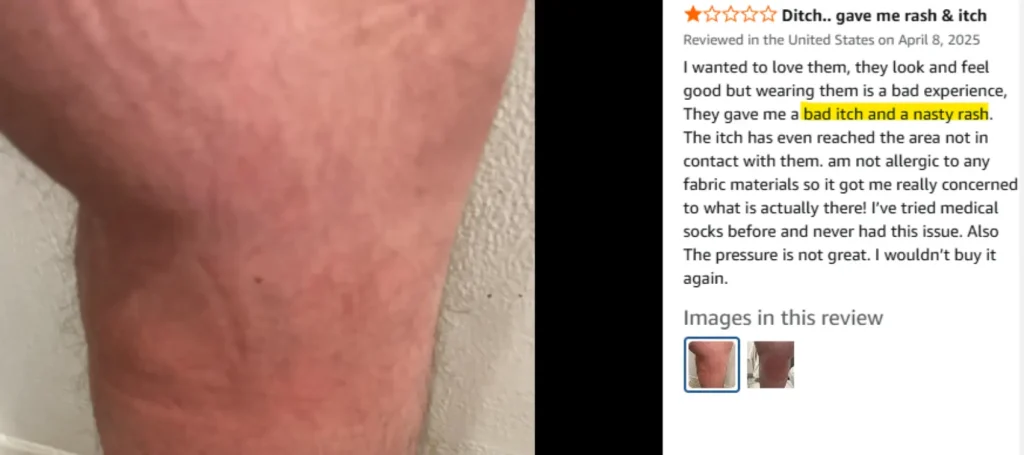
A widespread myth is that wearing compression socks for longer hours, especially overnight, will always improve results. The truth is more nuanced. Excessive or prolonged use of compression socks during sleep can actually cause problems rather than help.
Potential negative effects include:
- Numbness or tingling sensations in the legs;
- Skin irritation from trapped moisture and friction;
- Reduced sleep quality caused by discomfort or pressure.
By debunking these misconceptions, brands can better educate customers on safe and effective compression sock use, enhancing customer satisfaction and reducing misuse.
Risks of Wearing Compression Socks at Night
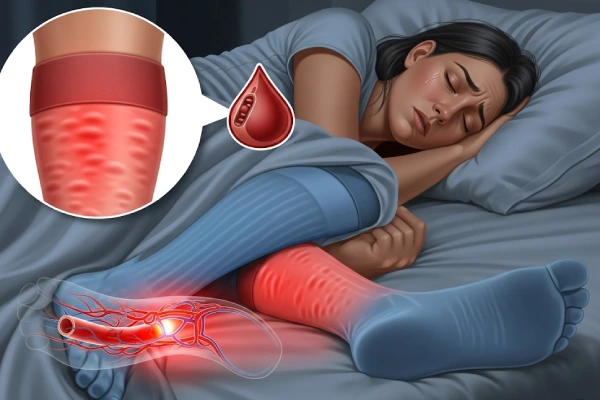
For many people, wearing compression socks while sleeping offers little extra advantage and may even pose health risks. It’s important to communicate these risks clearly to customers to help them make informed decisions.
Some of the primary concerns are:
Skin Irritation and Rashes
Tight compression socks can trap sweat and moisture against the skin overnight, creating an environment prone to bacterial growth and irritation. The friction from fabric rubbing can cause redness, itching, or rash, especially for customers with sensitive or delicate skin.
Circulation Problems from Over-Compression
If the socks apply excessive pressure, they might restrict rather than improve blood flow. This can lead to pressure ulcers—small but painful wounds caused by reduced circulation—and nerve compression, which results in numbness or tingling that may persist beyond the night.
Disrupted Sleep Quality
Wearing overly tight compression socks overnight may prevent customers from getting restful sleep. Discomfort or the need to adjust or remove socks during the night interrupts the natural sleep cycle, potentially offsetting the recovery benefits compression socks provide during the day.
When Nighttime Use Might Be Safe
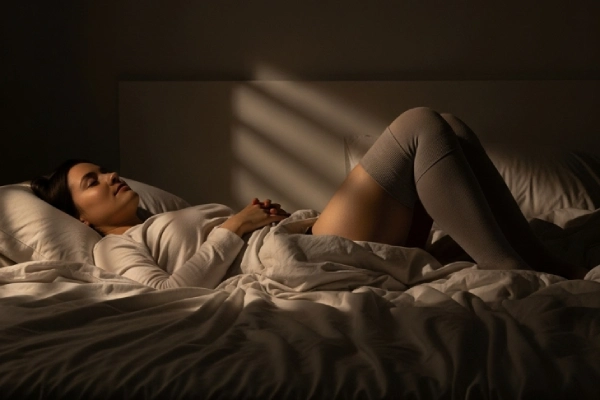
Although wearing compression socks overnight is generally not advised for most people, there are specific medical situations where it can be beneficial—but only under healthcare professional supervision.
Medical Supervision Cases
- Post-Surgery Recovery: After certain surgeries, especially those involving veins or legs, doctors may recommend wearing compression socks at night to lower the risk of blood clots and promote healing.
- Lymphedema Management: For patients with lymphedema, gentle compression during sleep can help control swelling and prevent fluid buildup.
- Chronic Venous Insufficiency (CVI): In severe cases of CVI, doctors might suggest continuous use, including overnight, to reduce symptoms such as leg heaviness and swelling.
Lower Compression Levels for Overnight Wear
If a healthcare provider approves nighttime use, the recommended pressure level is typically lower—around 15–20 mmHg. This mild compression offers support without risking skin irritation or impaired circulation. Higher compression levels should only be worn at night with strict medical guidance to avoid adverse effects.
Proper Fit Is Critical
Proper sizing is especially important when compression socks are worn overnight. Wrinkles or bunching fabric can create uncomfortable pressure points, increasing the risk of skin damage. Customers should measure their ankle and calf sizes before purchase to ensure a snug yet comfortable fit that does not constrict circulation.
How to Choose the Right Compression Socks for Night Use
When advising customers about nighttime compression sock wear, it is important to emphasize safety and comfort.
- Select the Appropriate Compression Level: 15–20 mmHg provides gentle, safe support during sleep. Avoid stronger pressures without medical approval.
- Ensure Accurate Sizing: Measuring the ankle, calf, and sometimes thigh helps find socks that fit well, preventing bunching or excessive tightness.
- Opt for Breathable, Moisture-Wicking Fabrics: Materials like nylon blends, cotton, or bamboo yarn promote airflow and reduce moisture buildup, minimizing skin irritation risks.
By guiding customers to the right products, you help them safely benefit from compression therapy during both day and night.
Tips for Wearing and Caring for Compression Socks
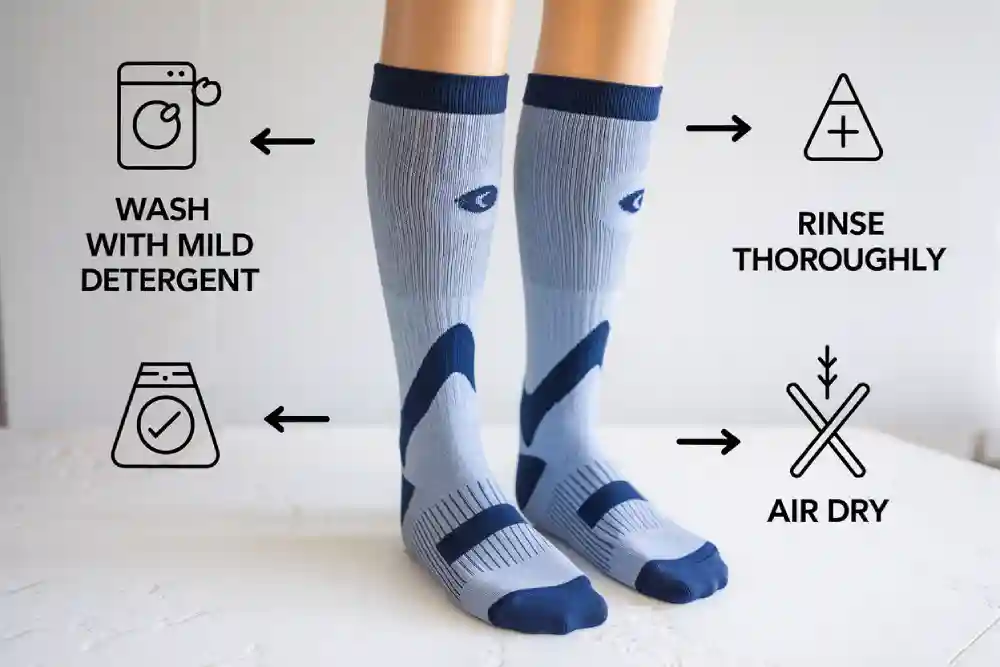
Proper usage and maintenance are essential to maximize the benefits of compression socks and prolong their lifespan.
Wearing Tips:
- Put socks on in the morning when leg swelling is minimal.
- Ensure the fabric lies flat and smooth to avoid pressure points.
- Remove socks if discomfort or numbness occurs, and consult a healthcare professional if symptoms persist.
Care Tips:
- Wash compression socks regularly to remove sweat and oils that can degrade elasticity.
- Avoid using fabric softeners, which may reduce compression effectiveness.
- Replace socks every 3–6 months depending on wear frequency to maintain proper pressure levels.
Special Considerations for Specific Groups
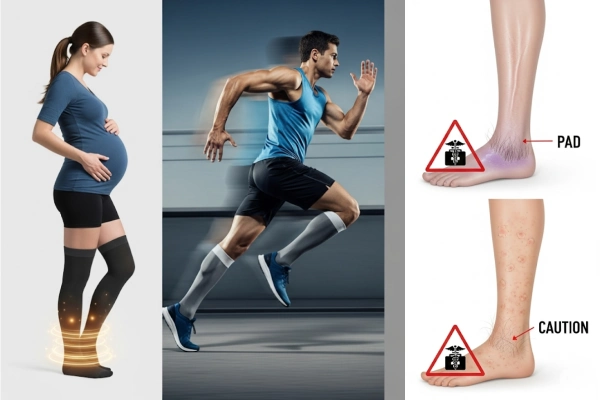
Certain groups require extra caution or professional advice when considering compression socks for nighttime use.
Pregnant Women
Pregnant women often experience leg swelling and may benefit from compression socks during the day. However, it’s important they consult their healthcare provider before wearing compression socks overnight. Improper pressure or prolonged use might affect circulation or cause discomfort, so medical guidance ensures safe and effective use.
Athletes
Athletes typically use compression socks to aid recovery after training or competitions. While these socks help reduce muscle fatigue and improve blood flow during activity or rest, nighttime use is usually unnecessary. The body naturally recovers during sleep without extra compression, so unless advised by a medical professional or coach, athletes should avoid wearing compression socks overnight.
People with Peripheral Arterial Disease (PAD) or Skin Conditions
Individuals with PAD face challenges with blood flow that may worsen with compression socks, especially during sleep. Likewise, those with skin conditions such as eczema or dermatitis have an increased risk of irritation from prolonged sock wear. It is essential that these individuals consult healthcare professionals before using compression socks at night to ensure safety.
FAQ
How can I educate my customers on the safe use of compression socks?
Provide guidance on proper fit, compression level, and daytime use. Ensure they understand when compression socks should be worn for optimal benefits.
What should I tell customers about the risks of wearing compression socks overnight?
Wearing compression socks at night can cause skin irritation, restrict circulation, and disrupt sleep. It’s best to avoid nighttime use unless advised by a healthcare professional.
What are the signs that my customers are wearing compression socks incorrectly?
If customers experience discomfort, skin irritation, numbness, or swelling, they may be wearing socks that are too tight or ill-fitting. Ensure they follow proper sizing and fit guidelines.
Are there any specific health conditions where compression socks should be worn at night?
Yes, individuals with severe lymphedema, post-surgery recovery, or chronic venous insufficiency may benefit from nighttime use under medical supervision.
Can compression socks help prevent blood clots for my customers?
Yes, compression socks are often recommended to reduce the risk of blood clots, particularly during long periods of sitting, such as on flights or for those recovering from surgery.
For Brands and Retailers: Why This Matters
Educating customers about safe compression sock use builds trust and reduces the risk of misuse, enhancing your brand’s reputation. Providing high-quality, customized compression socks tailored to your customer’s needs ensures satisfaction and loyalty.
Our factory specializes in custom compression socks with tailored yarn blends and certified production. We help brands deliver safe, comfortable, and effective products worldwide.
